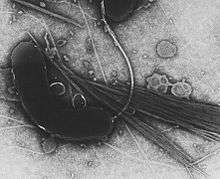1961–75 cholera pandemic
The seventh cholera pandemic was the seventh major outbreak of cholera and occurred from the years 1961 to the 1970s and has continued (though much diminished) to the present.[1] This outbreak, based on the strain called El Tor, started in Indonesia in 1961 where it spread to Bangladesh by 1963.[2] Then it went to India in 1964. It made it to the USSR by 1966. In 1972 there were reports of outbreaks in Baku, but the USSR kept this information quiet.[2] It reached Italy in 1973 from North Africa. Japan and the South Pacific saw a few outbreaks by the late 1970s. [2] In 1971, the number of cases reported worldwide was 155,000. In 1991, it reached 570,000.[1] The spread of the disease was helped by modern transportation and mass migrations. Mortality rates, however, dropped markedly as governments began modern curative and preventative measures. The usual mortality rate of 50% dropped to 10% by the 1980s and less than 3% by the 1990s.[1] The strain made a comeback in 1991 in Latin America. It has been shown that the strain can trace its origins to that of the seventh cholera pandemic.[3] It was suspected the strain came to Latin America through Asia from contaminated water. It has since been shown that identical matches have been found between samples from Latin America and samples from Africa.[4] This outbreak started in Peru and has killed roughly 10,000 people.[5]
See also
External links
References
- 1 2 3 Hays, J. N. (2005-01-01). Epidemics and Pandemics: Their Impacts on Human History. ABC-CLIO. ISBN 9781851096589.
- 1 2 3 "CHOLERA". www.austincc.edu. Retrieved 2015-11-24.
- ↑ "WHO | Global epidemics and impact of cholera". www.who.int. Retrieved 2015-11-24.
- ↑ "Evolution of Seventh Cholera Pandemic and Origin of 1991 Epidemic, Latin America - Volume 16, Number 7—July 2010 - Emerging Infectious Disease journal - CDC". wwwnc.cdc.gov. Retrieved 2015-11-24.
- ↑ "Cholera's seven pandemics". www.cbc.ca. Retrieved 2015-11-24.
